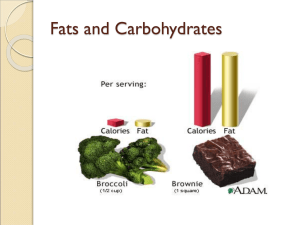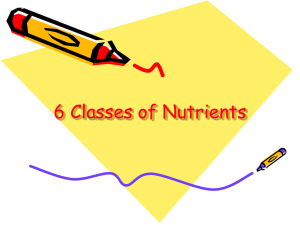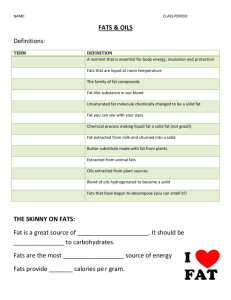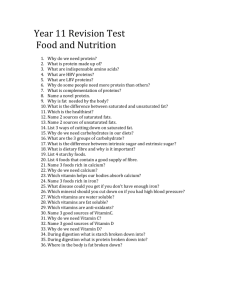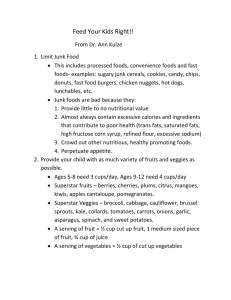What`s In the Raw? - High School Activities
advertisement
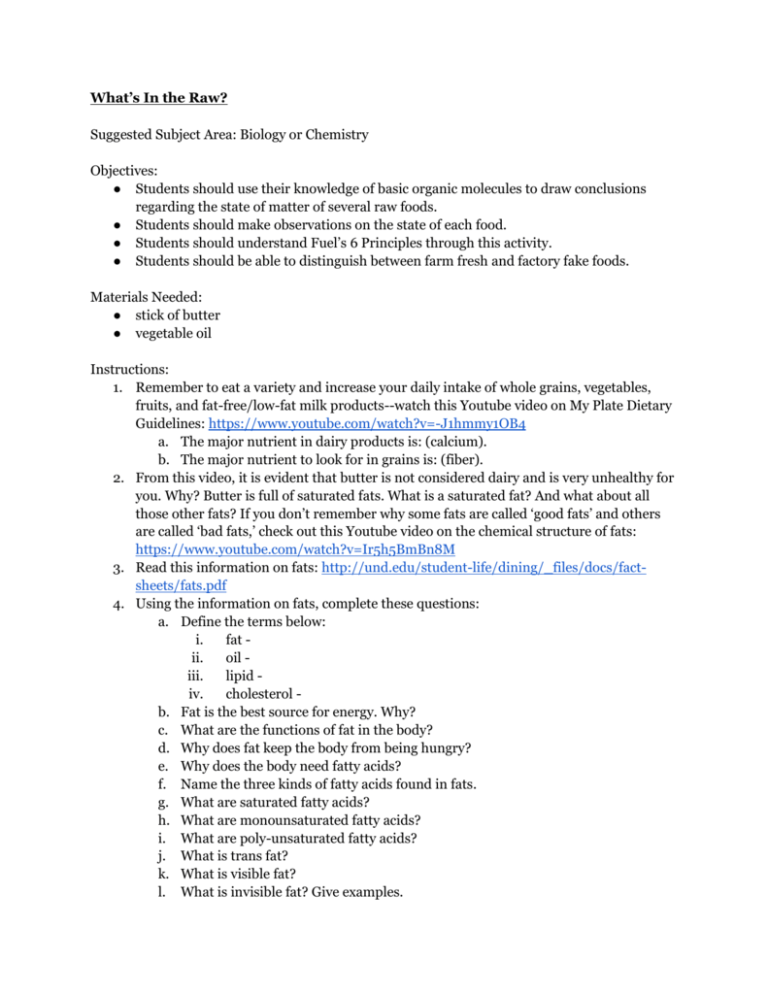
What’s In the Raw? Suggested Subject Area: Biology or Chemistry Objectives: ● Students should use their knowledge of basic organic molecules to draw conclusions regarding the state of matter of several raw foods. ● Students should make observations on the state of each food. ● Students should understand Fuel’s 6 Principles through this activity. ● Students should be able to distinguish between farm fresh and factory fake foods. Materials Needed: ● stick of butter ● vegetable oil Instructions: 1. Remember to eat a variety and increase your daily intake of whole grains, vegetables, fruits, and fat-free/low-fat milk products--watch this Youtube video on My Plate Dietary Guidelines: https://www.youtube.com/watch?v=-J1hmmy1OB4 a. The major nutrient in dairy products is: (calcium). b. The major nutrient to look for in grains is: (fiber). 2. From this video, it is evident that butter is not considered dairy and is very unhealthy for you. Why? Butter is full of saturated fats. What is a saturated fat? And what about all those other fats? If you don’t remember why some fats are called ‘good fats’ and others are called ‘bad fats,’ check out this Youtube video on the chemical structure of fats: https://www.youtube.com/watch?v=Ir5h5BmBn8M 3. Read this information on fats: http://und.edu/student-life/dining/_files/docs/factsheets/fats.pdf 4. Using the information on fats, complete these questions: a. Define the terms below: i. fat ii. oil iii. lipid iv. cholesterol b. Fat is the best source for energy. Why? c. What are the functions of fat in the body? d. Why does fat keep the body from being hungry? e. Why does the body need fatty acids? f. Name the three kinds of fatty acids found in fats. g. What are saturated fatty acids? h. What are monounsaturated fatty acids? i. What are poly-unsaturated fatty acids? j. What is trans fat? k. What is visible fat? l. What is invisible fat? Give examples. m. n. o. p. Name four fat soluble vitamins. What are the richest sources of fat in the diet? What is hydrogenation? Fats add flavor to food. Which fats add the most flavor? Which fats add the least flavor? q. Why is it important to store fats and oils in tightly covered containers? r. What happens when fats are heated to high temperatures? s. When using fat in a deep-fat fryer what precautions need to be taken? 5. Answer Key // Source: gactaern.org/Unit%20Plan/.../FCS_FNW_4A_Fats&OilsWorksheet.doc a. Define: i. FAT - an essential nutrient that provides the body with energy found in food and utilized by the body ii. OIL - fats that are liquid at room temperature iii. LIPID - a family of chemical compounds, which include fats and oils iv. CHOLESTEROL - a fat-like substance made of glucose or saturated fatty acids b. Fat serves well in emergencies when extra fuel is needed. c. Fat supplies heat and energy; it also carries Vitamins A, D, E, and K through intestinal system and acts as storage for body reserves. d. Fat remains in the body longer than other foods and gives a sensation of being full. e. Fatty acids transport other molecules such as fat-soluble vitamins. f. 1. Saturated 2. Polyunsaturated 3. Monounsaturated g. Saturated fats usually from animal sources (cheese, milk, meat, palm oil, coconut oil) and are usually solid at room temperature. h. Monounsaturated fatty acids are usually semi-solid or liquid at room temperature such as vegetable or fish oils. i. Polyunsaturated fats are found in vegetables and fish and are generally semiliquid at room temperature. j. Trans fat is found in snack foods and is made when an unsaturated fat molecule is chemically changed. k. Visible fat can be detected by the eye, such as the fat on and around the animal muscles. l. Fat soluble vitamins protect the body's organs from injury and insulate against shock. m. Vitamins A, D, E, and K n. The richest sources of fat in the diet are animal tissue, milk products, egg yolks (anything that can walk, swim or fly). o. HYDROGENATION - process that causes fats and oils to become more solid p. Animal and fish fats - butter, bacon, olive oil give distinctive flavor. Vegetable oils add the least amount of flavor. q. To prevent excessive exposure to air and spoilage, store fats and oils in tightly covered containers. r. When fats are heated to high temperatures, fatty acids break down and can change flavor of food. s. Dry food off before lowering into fat, do not salt food over oil, and control the temperature. Deep-fat fryers can severely burn the skin. 6. Place a stick of butter in one beaker and 100 mL of vegetable oil in another beaker. Make observations. Cover the beakers and let them sit overnight. 7. Uncover the beakers and make observations. 8. Discussion Questions: a. Why did neither food change their state of matter? b. How does this lack of change relate to their chemical structures? What kinds of c. From your observations, which food is more fresh? Which food is more processed? d. Which food is better for your body? e. Remember to consume less saturated and trans fats and more unsaturated fats.




